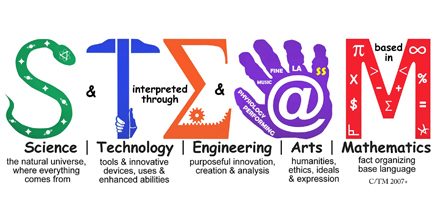30/10/18 – 06/11/18 – STEM to STEAM
“STEAM is an educational approach to learning that uses Science, Technology, Engineering, the Arts and Mathematics as access points for guiding student inquiry, dialogue, and critical thinking. The end results are students who take thoughtful risks, engage in experiential learning, persist in problem-solving, embrace collaboration, and work through the creative process. These are the innovators, educators, leaders, and learners of the 21st century!” (Education Closet, 2016)
In recent years education systems have been trying to incorporate more of the arts into the children’s learning by integrating different subjects and by creating connections between standards, assessments and lesson design. By doing this it promotes the children’s learning, getting them to expand how they think and their ideas, change how they see things and how they can transfer the skills they learn into other aspects of life.
To help us gain an understanding of how we could combine these aspects together, we got the opportunity to have a play around with a piece of software called GarageBand. Therefore, combing technology with the expressive arts, more specifically music. The software allowed us to create our own music by clicking and choosing an instrument and then picking a sound from a list of possibilities. After that we could then layer the sounds on top of each other to create a final track.
Using music in education helps children grow and develop in other aspects of their education and develop skills and traits that will help them in the future. It allows them to be creative and express their individual preferences and ideas through the arts.
Melanie Skankey explains this further and helps create a clearer understand for professionals as to what integrating the arts really means and how it can change education for the better.
https://www.youtube.com/watch?v=T70fZeyMulw
“Creativity is a process which generates ideas that have value to the individual. It involves looking at familiar things with a fresh eye, examining problems with an open mind, making connections, learning from mistakes and using imagination to explore new possibilities” (Education Scotland, 2013). These are just a few benefits from using the STEAM approach and creating links for the children between the subjects and letting them explore their creativity and imagination through new and interesting ways.
Reference List:
Education Closet (2016) STEAM Portal, Available at: https://educationcloset.com/steam/what-is-steam/ (Accessed: 7th November 2018).
TED Conferences, LLC (2013) Arts integration: putting the A into STEAM curriculum, Available at: https://www.youtube.com/watch?v=T70fZeyMulw (Accessed: 7th November 2018).
Education Scotland (2013) Creativity Across Learning 3-18, Available at: https://education.gov.scot/improvement/Documents/cre39-impact-report.pdf (Accessed: 21st November 2018).

